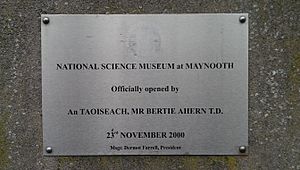National Science Museum at Maynooth facts for kids

Plaque at entrance
|
|
| Lua error in Module:Location_map at line 420: attempt to index field 'wikibase' (a nil value). | |
| Former name | Museum of Ecclesiology |
|---|---|
| Established | 1934 |
| Location | Maynooth, County Kildare, Ireland |
| Type | Science museum Ecclesiology museum |
| Public transit access | Maynooth Dublin Bus routes: C3, C4, C5, C6 Go-Ahead Ireland routes: W6 |
The National Science and Ecclesiology Museum at Maynooth is a cool place to visit in Maynooth, Ireland. It's a special museum that shows off both amazing science inventions and interesting church history. You can find it on the campus shared by St Patrick's College, Maynooth and Maynooth University.
This museum has lots of old science tools and machines, making it the biggest collection like this in Ireland that you can visit. It also has many items used by a famous Irish scientist named Nicholas Callan. Plus, you can see a special mold of the face of an important Irish leader, Daniel O'Connell, made after he passed away. The museum started in 1934, focusing on church history, but it has grown to include much more science, especially because of Nicholas Callan's work.
Contents
Museum History
How the Museum Started
The museum first opened in 1934. Back then, it was called the Museum of Ecclesiology. It was part of St. Patrick's College. Dr. William Moran, a professor, was the first person in charge of the museum.
When Dr. Moran left in 1942, Dr. Patrick J McLaughlin took over. He was a physics professor. He helped move many of Nicholas Callan's science tools into the museum. Another person, Rev. Dr. Michael Casey, finished this important job.
What You Can See
Nicholas Callan's Amazing Inventions
The museum has two main types of collections. One is all about the scientific tools and inventions of Nicholas Callan. He was a brilliant scientist!
You can see the very first induction coil he invented in 1836. This was a huge deal in electricity! There are also other induction coils he made. One is a giant coil from 1845. It could create a massive 600,000 volts of electricity!
This giant coil had two parts: a primary coil and a secondary coil. It had over twenty miles of wires inside! Each wire was carefully wrapped by hand with beeswax to keep it insulated. Callan even used students holding hands to test how strong the electric current was. He watched how high they jumped to figure it out! He also worked with a local blacksmith to build a large electromagnet in 1836. The museum also has old papers and books, including a special patent for galvanization.
The museum also has many old batteries from the 1800s. You can see a Norremberg polariscope, which is a tool for studying light. There's also an old microscope from the 1800s that uses light in a special way.
A really cool item is the first portable GPS device! Imagine having that back then. The museum also displays tools used for navigation, like several octants and sextants. These were used to help sailors find their way by looking at the stars. The octant was improved in 1731 and became the basis for the modern sextant. One octant in the museum has the name 'Yeates' on it, likely referring to a toolmaker from the 1800s.
Church History Items
The other main collection is about church history. You can see special robes worn by priests. One set was even made for Marie Antoinette, a queen!
There's an old artwork called Ecce Homo from the 1100s. You can also see part of an ivory diptych from the 1300s, which is a two-part artwork. The museum also has special altar stones and a statue of Jesus. This statue was damaged by soldiers during a battle in 1649.
Visiting the Museum
If you want to visit, the museum is open from June to September 2025. You can go on Thursday, Friday, and Saturday. It's open from 12:00 PM to 2:00 PM and again from 3:00 PM to 5:00 PM. You can also ask for a special tour if you contact the museum's curator.
Images for kids







